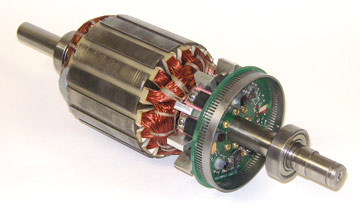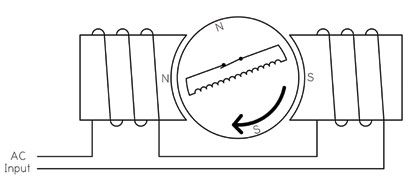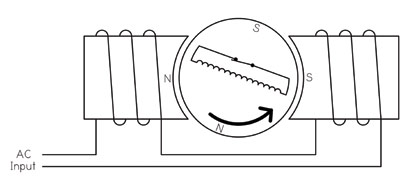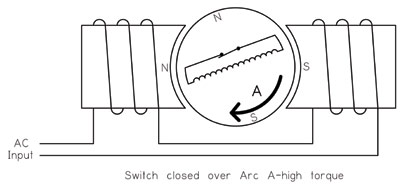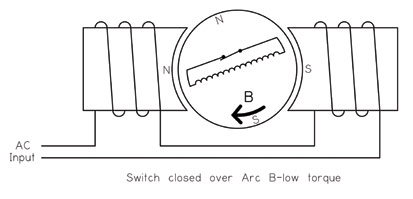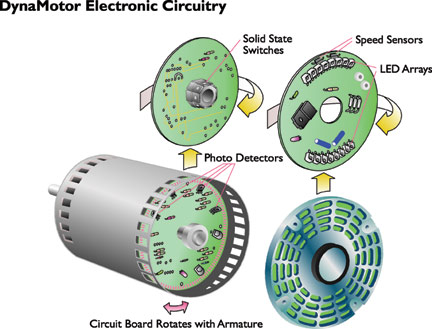High pole count motors have existed for years, and are in use today in some specialty industrial applications. They typically provide slower operation (without a drive), but the horsepower is reduced as the pole count increases. A new concept for high pole count motors has recently been patented by DynaMotors, Inc of Cleveland, OH.
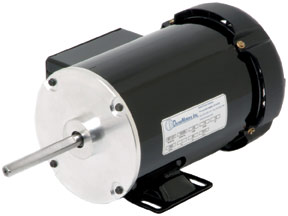 The DynaMotor™ is a brushless AC motor that runs at variable speeds by means of electronic switches embedded in the motor’s wound rotor. These rotating switches regulate current flow in the rotor and thus the motor’s torque and speed. The DynaMotor’s characteristics include variable speed operation on single phase power, high torque at low speed, reduced RFI, completely integrated controls, and the ability to operate on GFCI protected circuits. Prototypes of the DynaMotor are being tested in various industrial applications, and the results are very promising. DynaMotors, Inc. is seeking additional manufacturing partners, and production motors may be on the market by the end of 2008.
The DynaMotor™ is a brushless AC motor that runs at variable speeds by means of electronic switches embedded in the motor’s wound rotor. These rotating switches regulate current flow in the rotor and thus the motor’s torque and speed. The DynaMotor’s characteristics include variable speed operation on single phase power, high torque at low speed, reduced RFI, completely integrated controls, and the ability to operate on GFCI protected circuits. Prototypes of the DynaMotor are being tested in various industrial applications, and the results are very promising. DynaMotors, Inc. is seeking additional manufacturing partners, and production motors may be on the market by the end of 2008.
How It Works
The DynaMotor looks like an ordinary AC or DC motor. It is the same shape and size, and is made from the same mechanical parts, laminations, windings, shaft, end-bells, bearings and housing. The difference is that the DynaMotor™ uses optically controlled solid-state switches embedded in its rotor windings. Opening and closing these switches controls the current, and thus the torque, right where it is being produced. The result is a self-contained variable-speed motor.
The DynaMotor™ is constructed like a DC motor, or universal motor with two or more opposed salient poles whose copper windings are connected directly to the AC line.
The rotor is similar to universal and DC motors, consisting of slotted steel laminations stacked on a shaft. Copper wire is wound in the rotor slots and the ends of each coil are connected by a solid-state switch, such as a transistor. In contrast, universal and DC motors have each coil connected to copper bars in a commutator that receives external power through carbon brushes.
When the stator windings are connected to an AC line, a resultant magnetic field varies with the line current and magnetic poles are created. The stator flux passes through the rotor inducing a voltage in each rotor coil by transformer action. However, with the switch open, no rotor current can flow and no torque is produced.
When the solid- state switch is closed, current flows through the rotor coil. This produces flux and a magnetic pole. If the position of the rotor is such that its magnetic pole is not aligned with the magnetic pole in the stator, the non-aligned magnetic poles produce force. The tangential component of that force is torque and rotation occurs. The torque generated varies with the position of the rotor with respect to the stator.
If the rotor’s switch is closed when its coil is on the opposite side of the stator pole, then torque is produced in the opposite direction.
Torque and Speed Adjustment
The torque produced by the motor depends on the position of the rotor when the switch is closed, and the duration (over what rotational angle) the switch is closed. When the switch is open, current cannot flow and no torque or rotation is produced by the coil. Closing the switch for a long period produces high torque. Closing the switch for a shorter period produces less torque.
Each rotor switch is actuated by a dedicated photo-detector as it rotates past a stationary illuminated infrared light-emitting diode (LED). An array of LEDs mounted on the motor end-bell can be turned on for varying amounts of time to adjust the motor’s torque and speed.
Since there are multiple coils on the rotor that can be energized simultaneously and controlled individually, continuous smooth torque can be produced.
If operated open loop, the motor control’s torque and speed may vary depending on the load. To precisely control and maintain speed, regardless of changes in load or other external factors such as temperature or input voltage, a simple internal optical speed sensor is used. This speed sensor compares the motor’s actual speed with an external speed command signal and varies torque to produce the desired speed. The external speed signal can be a potentiometer, a variable voltage signal or a digital speed command. The microprocessor speed controller contains the functions usually provided by a variable speed drive, such as ramp rates and min/max speeds.
DynaMotor Characteristics
The DynaMotor’s unique design leads to characteristics quite different than conventional motors and drives:
High Torque at Low Speed
In an ordinary AC induction motor, increasing the number of stator poles decreases the motor’s base speed by the same ratio. However, the torque does not change and the horsepower the motor can produce decreases. In the DynaMotor, adding stator poles decreases the speed but the motors torque increases proportionately so constant horsepower is maintained. As shown below, at speeds of 200 to 800 rpm, a NEMA 56 frame DynaMotor can produce over three times the torque of a comparably sized 4-pole AC
induction motor and drive.
This characteristic enables the DynaMotor to run equipment in the low speed range directly without mechanical speed reducers such as gear boxes, and reduces the number of reduction stages even if lower speeds are required. This eliminates the size, weight, cost, maintenance, and losses inherent in gear boxes or other mechanical speed reducers.
No High Frequency PWM Switching
In conventional AC induction motor/drives, the incoming AC power is converted to DC, and then inverted back to variable voltage/frequency AC; this is usually done by high frequency pulse width modulation (PWM). PWM switching can generate significant amounts of audible whine, Radio Frequency Interference (RFI), poor motor insulation life, and ground currents. RFI can interfere with the operation of other controllers, computers, sensors, and communication devices. In contrast, the DynaMotor’s stator connects directly to the AC line. Switching occurs on the rotor at about 300 Hz producing essentially no RFI (shown below). The filtering, shielding or extraordinary grounding techniques necessary with AC drives are not required with the DynaMotor.
In addition to radiated noise, conventional AC drives can create power line noise. The stator of the DynaMotor acts as a filter, reducing noise injected back onto the power line, and also protects the DynaMotor’s electronics from power line noise generated by other equipment.
PWM switching in conventional motor/drives creates ground currents due to capacitive coupling to ground, which shortens bearing life and prevents operation on GFCI protected circuits. The DynaMotor produces no measurable ground current.
Integrated Electronics
Conventional AC or DC controllers are typically mounted remotely from the motor. The DynaMotor has the control electronics integrated into the motor, eliminating the separate controller and its enclosure as well as the wiring from the controller to the motor. In many cases the DynaMotor is simply plugged into a receptacle, which eliminates the possibility of wiring errors or loose connections.
56/60 Hz Operation
The speed of AC induction motors depend on the frequency of their input power. The speed of the DynaMotor is independent of line frequency; therefore it can operate equally well on 50 or 60 Hz power.
The speed is also not affected by fluctuations in input voltage.
Reliability
The DynaMotor is unique in that it has rotating electronics. Simple, inexpensive, and effective techniques have been developed to ensure the integrity of the rotating printed circuit board. These techniques have been verified by extensive accelerated life testing, including over-speed operation. This is especially effective as the forces on the electronics increase by the square of the speed. Over-speed tests have been successfully conducted at 15,000 rpm on boards designed to operate at 3000 rpm, which subjects the electronics components to forces 25 times what they experience in normal operation.
Applications
As a result of its unique characteristics, the DynaMotor has demonstrated the ability to power a wide range of applications such as mixers, pumps, fans, material handling systems, lathes, saws, and many other machines.
For more info visit: www.dynamotors.com
Or contact:
Doug Toman
General Manager
DynaMotors Inc.
4945 B Pointe Parkway
Warrensville Heights, OH 44128
Ph: 216-292-7278
Fax: 216-292-7288
dtoman@dynamotors.com
By Doug Toman
General Manager
DynaMotors, Inc.
Originally Published: June 1, 2008



